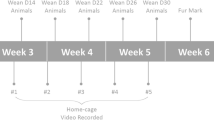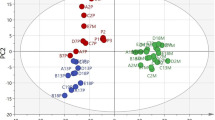Abstract
DURING the past 20 years considerable attention has been drawn to the effects of altered litter size on the growth and development of various mammals. Studies with rodents have shown that increasing litter size permanently reduces body growth by attenuating the rate of cell division and the final number of cells per organ1–5. Conversely, reduction of litter size enhances growth and development1,6–9. Altering litter size has also been shown to effect adult behaviour; by elevating emotional reactivity9–12, and reducing learning ability13 in pups raised in large litters, and by reducing emotionality in pups raised in small litters10–12. It is not known, however, how quickly behavioural differences may result from alterations in litter size. Moreover, it is unclear whether such behavioural effects are a consequence of nutritional changes or of alterations in the pups' developmental experiences. For example, behavioural differences may be due to alterations in maternal behaviour, as rats nursing small litters spend more time in the nest with these pups, and more time handling and manipulating them14,15. Additionally, varying litter size probably alters within litter competition for the nipples, and this may effect behavioural development as well. Utilising recently developed techniques for the measurement of suckling16–18 and activity19 we attempted to discover whether altering litter size directly affects the behaviour of pre-weanling rats. We now report that reducing litter size has the surprising effect of reducing both the willingness of pups to suckle and the vigour of their search behaviour on the mother. Moreover, these effects seem more directly linked to alterations in the litter experience than to nutritional differences.
This is a preview of subscription content, access via your institution
Access options
Subscribe to this journal
Receive 51 print issues and online access
$199.00 per year
only $3.90 per issue
Buy this article
- Purchase on Springer Link
- Instant access to full article PDF
Prices may be subject to local taxes which are calculated during checkout
Similar content being viewed by others
References
Kennedy, G. C. J. Endocr. 16, 9–17 (1957).
Widdowson, E. & McCance, R. A. Proc. R. Soc. Biol. 152, 188–206 (1960).
Winick, M. & Noble, A. J. Nutr. 89, 300–306 (1966).
Knittle, J. & Hirsch, J. J. clin. Invest. 47, 2091–2098 (1968).
Wurtman, J. J. & Miller, S. A. J. Nutr. 106, 697–701 (1976).
Ota, K. & Yokoyama, A. J. Endocr. 38, 263–268 (1967).
Winick, M. & Noble, A. J. Nutr. 91, 179–182 (1967).
Solomon, S. & Bengele, H. H. Biol. Neonatorum 22, 222–229 (1973).
Milkovic, K., Paunovic, J. & Joffe, J. M. Devl Psychobiol. 9, 365–375 (1976).
Seitz, P. F. D. Am. J. Psychiatry 110, 916–927 (1954).
LaBarba, R. C. & White, J. L. J. comp. physiol. Psychol. 75, 254–257 (1971).
Priestnall, R. Devl Psychobiol. 6, 217–224 (1973).
Barnes, H. R. et al. J. Nutr. 89, 399–410 (1966).
Grota, L. J. & Ader, R. Anim. Behav. 17, 722–729 (1969).
Priestnall, R. Anim. Behav. 20, 386–394 (1972).
Drewett, R. F., Statham, C. & Wakerley, J. B. Anim. Behav. 22, 907–913 (1974).
Hall, W. G., Cramer, C. P. & Blass, E. M. Nature 258, 318–320 (1975).
Hall, W. G., Cramer, C. P. & Blass, E. M. J. comp. physiol. Psychol. 91, 1141–1155 (1977).
Teicher, M. H. & Green, W. T. Physiol. Behav. 18, 747–750 (1977).
Bruning, J. L. & Kintz, B. L. Computational Handbook of Statistics 222–224 (Scott, Foresman, Glenview, Illinois, 1977).
Teicher, M. H. & Blass, E. M. Science 193, 422–425 (1976).
Bruning, J. L. & Kintz, B. L. Computational Handbook of Statistics 187–188 (Scott, Foresman, Glenview, Illinois, 1977).
Winer, B. J. Statistical Principles in Experimental Design 109–113 (McGraw-Hill, New York, 1971).
Hall, W. G. & Rosenblatt, J. S. J. comp. physiol. Psychol. 91, 1232–1247 (1977).
Friedman, M. I. J. comp. physiol. Psychol. 89, 636–647 (1975).
Author information
Authors and Affiliations
Rights and permissions
About this article
Cite this article
TEICHER, M., KENNY, J. Effect of reduced litter size on the suckling behaviour of developing rats. Nature 275, 644–646 (1978). https://doi.org/10.1038/275644a0
Received:
Accepted:
Issue Date:
DOI: https://doi.org/10.1038/275644a0
Comments
By submitting a comment you agree to abide by our Terms and Community Guidelines. If you find something abusive or that does not comply with our terms or guidelines please flag it as inappropriate.



